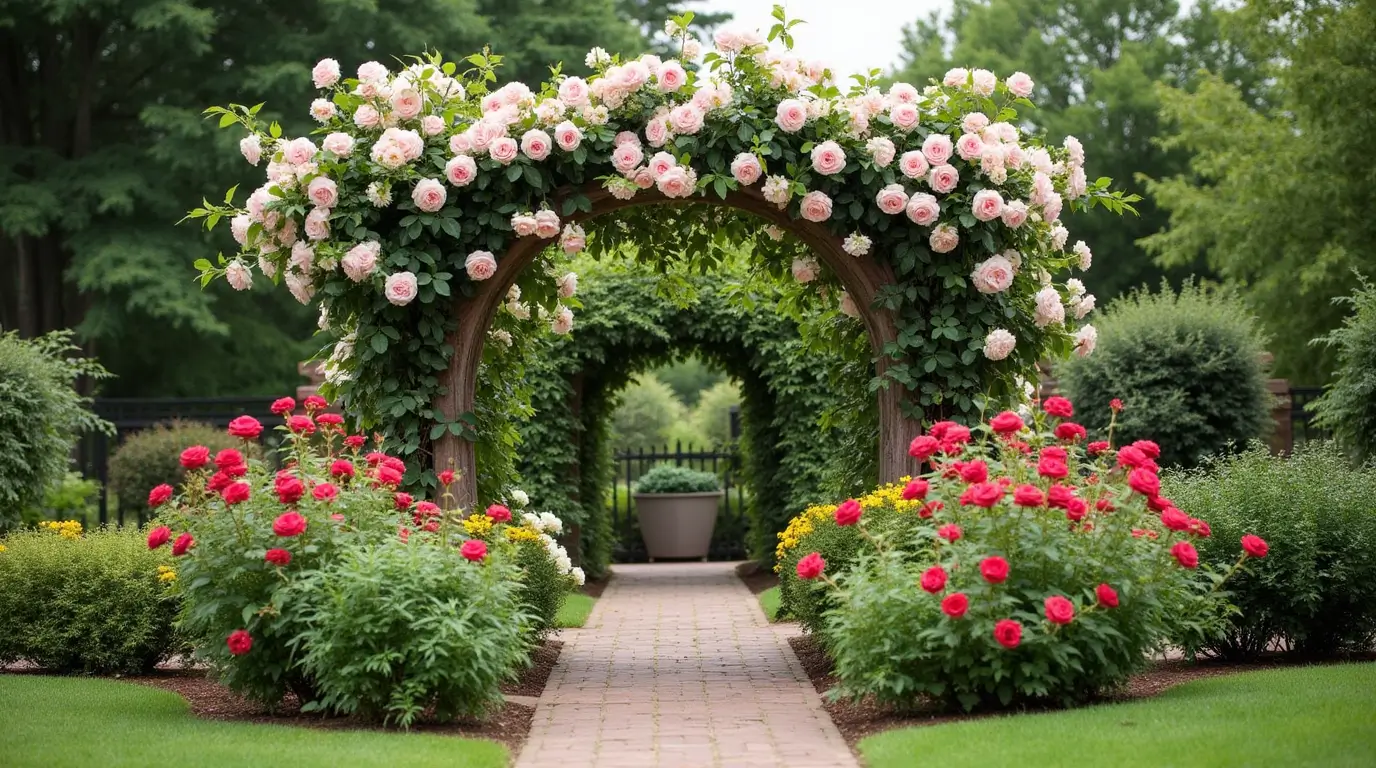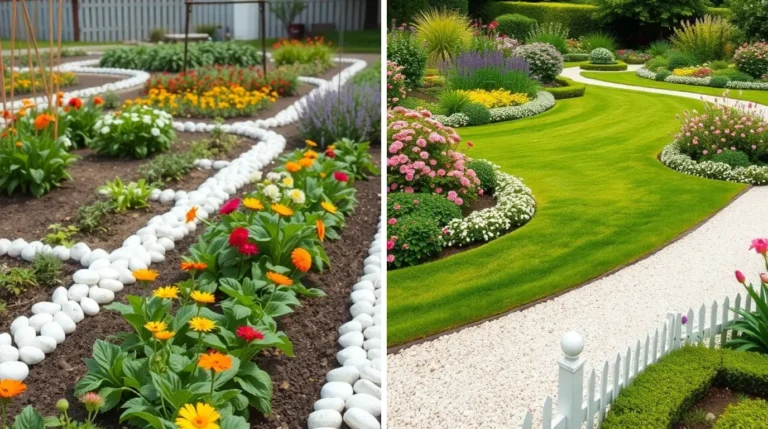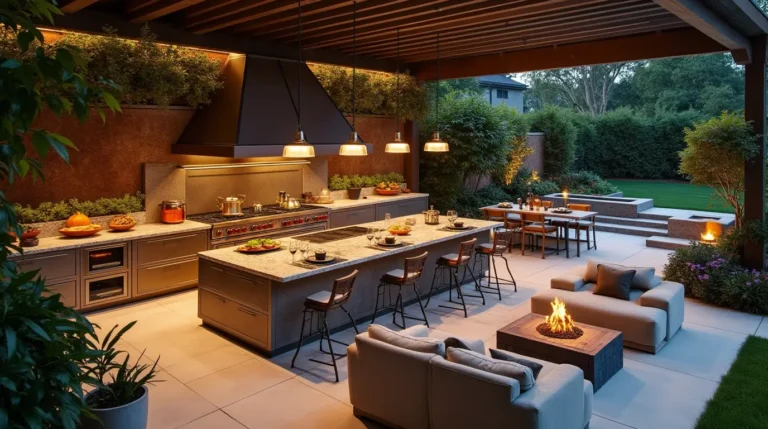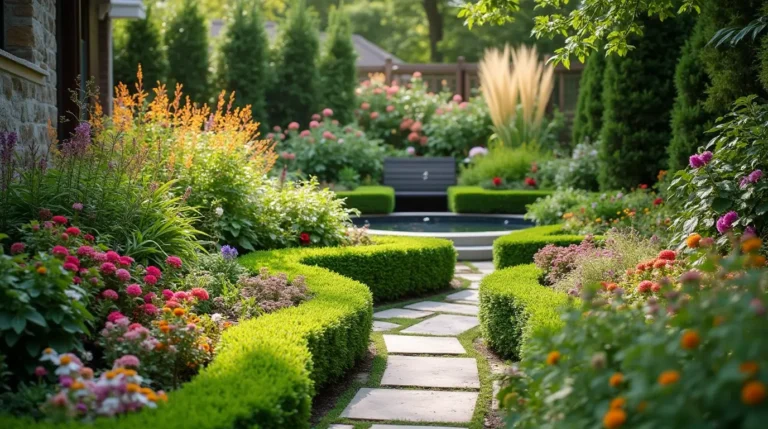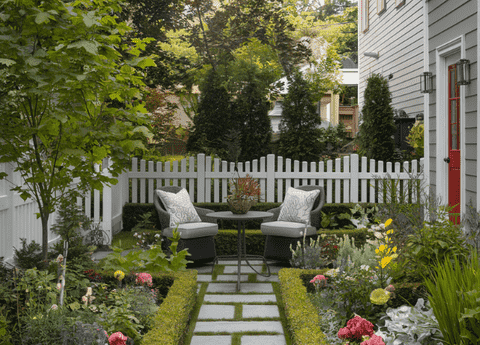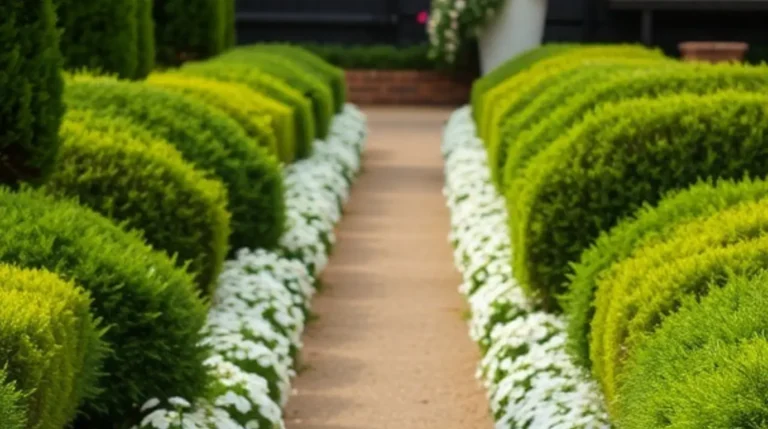From Borders To Arbors: Rose Landscaping Uses You’ll Love
Introduction
Roses have long been cherished as symbols of beauty, romance, and elegance. When it comes to landscaping, they are not only a timeless choice but also an incredibly versatile one. Rose landscaping uses have become increasingly popular among garden enthusiasts and professional landscapers alike, as these flowers offer a stunning visual appeal while serving several practical purposes. From vibrant rose borders to fragrant rose arbors, roses have the unique ability to transform any garden space into a lush, enchanting environment.
Incorporating roses into your garden design provides numerous aesthetic benefits. With their wide range of colors, sizes, and shapes, roses can complement virtually any garden style—whether it’s a classic English garden, a modern minimalist garden, or a wild cottage garden. The rich hues of red, pink, white, and yellow roses can create striking focal points, enhance the overall visual appeal, and introduce a delightful fragrance that enhances your outdoor space.
Beyond their beauty, roses serve functional purposes in landscaping as well. For instance, rose borders can act as natural privacy screens or windbreaks, while rose hedges provide an elegant and low-maintenance alternative to traditional fencing. Climbing roses, when trained over trellises or arbors, add a vertical element to your landscape, creating a charming and romantic atmosphere. Meanwhile, ground cover roses can help with soil erosion control and weed prevention, all while keeping maintenance needs to a minimum.
When strategically placed in key areas such as borders, arbors, and trellises, rose landscaping uses can truly elevate the character of your outdoor spaces. Whether you’re looking to create a formal garden design or simply want to add pops of color and fragrance, roses have the potential to transform any part of your landscape into a breathtaking, functional masterpiece. With just a little care and planning, your garden can become a showcase of rose-filled beauty that will impress year-round.
The Beauty of Rose Borders in Landscaping
What is a Rose Border?
A rose border is a defined planting area specifically designed to showcase a variety of roses, often placed along the edges of a garden or landscape. It acts as both a visual divider and a decorative feature, framing paths, walkways, or other garden areas. Rose landscaping uses in the form of borders are one of the most popular and timeless ways to incorporate roses into your garden. These borders serve not only as beautiful focal points but also as functional garden features that can help delineate spaces, create privacy, and add structure to a garden.
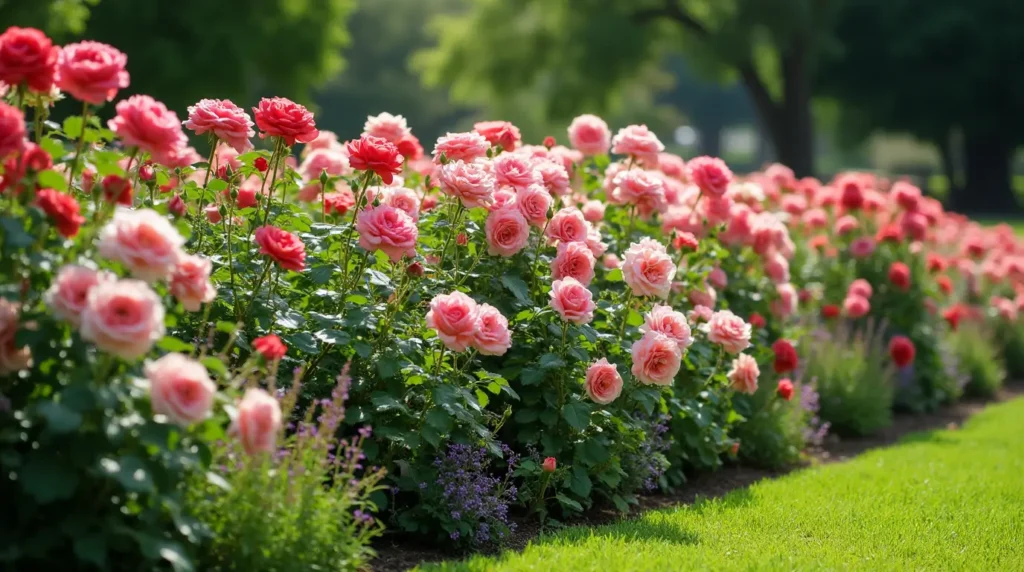
A well-planned rose border can elevate the design of any garden, whether it’s formal or informal. The vibrant, colorful blooms of roses, along with their lush green foliage, create a striking contrast against the backdrop of other plants, making them a stunning addition to flower beds, lawns, or even alongside garden paths. Rose borders can also be designed to provide seasonal interest, as different types of roses bloom at different times of the year, offering continuous color and beauty.
Creating Stunning Flower Beds with Roses
Planting roses in flower beds is an effective way to combine color, texture, and fragrance in your landscape design. When designing a rose border, it’s essential to select the right roses for the space and consider their growth habits. For example, shrub roses and floribundas are excellent choices for borders because they have a compact, bushy form and produce abundant flowers throughout the season. These types of roses thrive in the ground and can be planted in groups to create a dense, colorful display.
When planting roses in flower beds, it’s important to consider the spacing between each plant to allow for proper air circulation. Roses need space to grow and spread their branches, so crowding them too closely can lead to poor airflow and increase the risk of disease. A general guideline is to space shrub roses about 18 to 24 inches apart, depending on their variety, while floribundas can be spaced around 12 to 18 inches apart.
To add diversity to your rose borders, consider combining roses with other complementary plants. Lavender, with its silvery foliage and fragrant purple flowers, pairs wonderfully with roses, creating a fragrant and textured combination. Daisies, with their simple white petals, can soften the boldness of roses and create a more relaxed, natural look. Mixing roses with salvias, delphiniums, or hostas can also provide contrasting shapes and foliage that enhance the beauty of the border and keep it visually interesting throughout the growing season.
Maintaining Healthy Rose Borders
Once your rose border is planted, maintaining its health is essential to ensure the long-term beauty and vitality of your roses. Regular maintenance practices like pruning, watering, and fertilization will keep your roses thriving and producing abundant blooms year after year.
- Pruning Roses in Borders: Regular pruning is crucial for maintaining the shape of the rose bushes and encouraging healthy growth. For most rose varieties, it’s best to prune them in early spring, just as new growth begins to appear. Pruning helps to remove dead or diseased wood, encourages new shoots, and improves airflow. Cutting back spent flowers (deadheading) throughout the blooming season can also promote additional flowering.
- Watering Tips for Roses: Roses need consistent moisture, especially during dry periods, but they don’t like to sit in waterlogged soil. It’s best to water roses deeply but infrequently, ensuring the water reaches the roots. Early morning watering is ideal, as it helps reduce the risk of fungal diseases by allowing the foliage to dry during the day. Using a drip irrigation system or soaker hoses can also be beneficial for ensuring that water reaches the root zone without wetting the foliage.
- Fertilization for Thriving Rose Borders: Roses are heavy feeders and require regular fertilization to promote healthy growth and abundant blooms. Applying a balanced fertilizer in early spring, when new growth starts, and again in mid-summer will provide the necessary nutrients. Be sure to use a fertilizer that is specifically formulated for roses, as they require higher amounts of potassium and phosphorus to encourage strong blooms and root development. Organic options like compost or well-rotted manure can also help improve soil fertility and provide long-term nourishment for your roses.
By following these best practices for pruning, watering, and fertilizing, you’ll ensure that your rose landscaping uses in borders remain healthy and vibrant, offering beauty and charm to your garden year after year.
Rose Hedges: A Classic Landscaping Feature
Why Choose Roses for Hedges?
Roses are a sophisticated and versatile choice for creating hedges in your landscape. Unlike traditional hedge plants like boxwood or privet, rose hedges add a dynamic visual and sensory appeal. They combine the benefits of vibrant colors, lush foliage, and intoxicating fragrances, making them an ideal feature for both functional and aesthetic purposes. Rose landscaping uses in the form of hedges can serve multiple roles in your garden design.
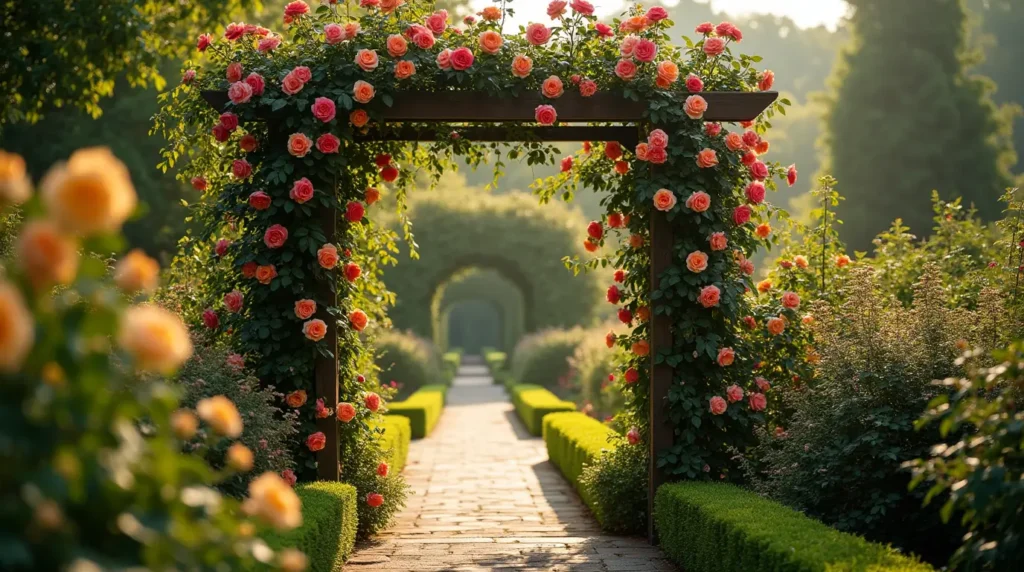
One key benefit of rose hedges is privacy. Tall or bushy rose varieties can form a natural barrier, shielding your space from prying eyes while maintaining a beautiful, inviting appearance. Rose hedges also act as effective windbreaks, providing protection for more delicate plants in your garden. Additionally, the burst of colors from their blooms enhances any landscape, offering seasonal interest and a charming backdrop to other garden features.
Beyond their aesthetic value, rose hedges can contribute to the overall health of your garden ecosystem. Their dense foliage provides shelter for birds, while their nectar-rich flowers attract pollinators like bees and butterflies. This makes them not only visually appealing but also beneficial for a thriving, biodiverse garden.
Best Rose Varieties for Hedges
Choosing the right rose varieties is essential for creating stunning and functional hedges. Some rose types are better suited to hedge formation due to their growth habits, size, and blooming characteristics. For rose landscaping uses, consider these top varieties for hedges:
- Shrub Roses: These are ideal for creating dense, bushy hedges. Varieties like Knock Out Roses or Rugosa Roses are hardy, low-maintenance, and bloom profusely throughout the season. Their compact form and resilience make them a favorite for informal hedges.
- Climbing Roses: For taller hedges, climbing roses like Iceberg or Eden Climber are excellent choices. They can be trained to grow along trellises or supports, adding height and drama to your hedge.
- Hybrid Tea Roses: Known for their large, showy blooms, hybrid tea roses like Mr. Lincoln or Peace offer a more formal and structured appearance. They work well in shorter, meticulously maintained hedges.
- Rambler Roses: If you want a hedge that looks more natural and less structured, rambler roses like American Pillar are perfect. These roses produce abundant blooms and grow rapidly, covering large areas with ease.
When selecting roses, consider factors like bloom time, color palette, and the amount of sunlight your hedge will receive to ensure the plants thrive in your landscape.
Creating a Formal Look with Rose Hedges
Formal rose hedges are a timeless landscaping element, perfect for framing garden paths, marking property boundaries, or adding structure to large landscapes. To achieve the clean lines and symmetry characteristic of formal designs, careful planning and maintenance are crucial. Here are a few tips to achieve a polished and professional appearance:
- Planting for Symmetry and Spacing: To achieve a uniform hedge, plant roses at consistent intervals, typically 18–24 inches apart, depending on the variety. Closer spacing ensures the plants grow together seamlessly, creating a continuous wall of foliage and blooms. Use a string line or stakes to maintain straight rows during planting for a neat, symmetrical appearance.
- Shaping and Pruning: Regular pruning is essential for maintaining the structure of formal rose hedges. Prune in early spring to shape the hedge, removing any dead or weak growth and encouraging dense foliage. Throughout the growing season, perform light trimming to keep the hedge tidy and encourage consistent blooming.
- Incorporating Support Structures: For climbing or rambler roses, use trellises, fences, or arches to guide their growth. These structures not only provide support but also enhance the visual appeal of the hedge.
- Consistent Maintenance: Water rose hedges deeply and regularly, ensuring the roots stay hydrated during dry periods. Applying mulch around the base helps conserve moisture and reduce weed growth. Fertilize the hedge in spring and mid-summer with a rose-specific fertilizer to promote healthy growth and vibrant blooms.
By combining thoughtful planning with ongoing care, your rose hedge can become a standout feature in your garden, blending beauty and functionality in perfect harmony. Whether you aim for a structured formal hedge or a lush, flowing border, rose landscaping uses in hedges offer endless possibilities to enhance your outdoor space.
Landscaping with Climbing Roses: Adding Vertical Interest
What Are Climbing Roses and How to Use Them
Climbing roses are a unique and versatile variety of roses that are characterized by their long, flexible canes. Unlike traditional roses, climbing roses don’t have the ability to cling to surfaces on their own but can be trained and supported to grow vertically. This makes them ideal for creating stunning vertical garden elements, adding both height and visual drama to any landscape.
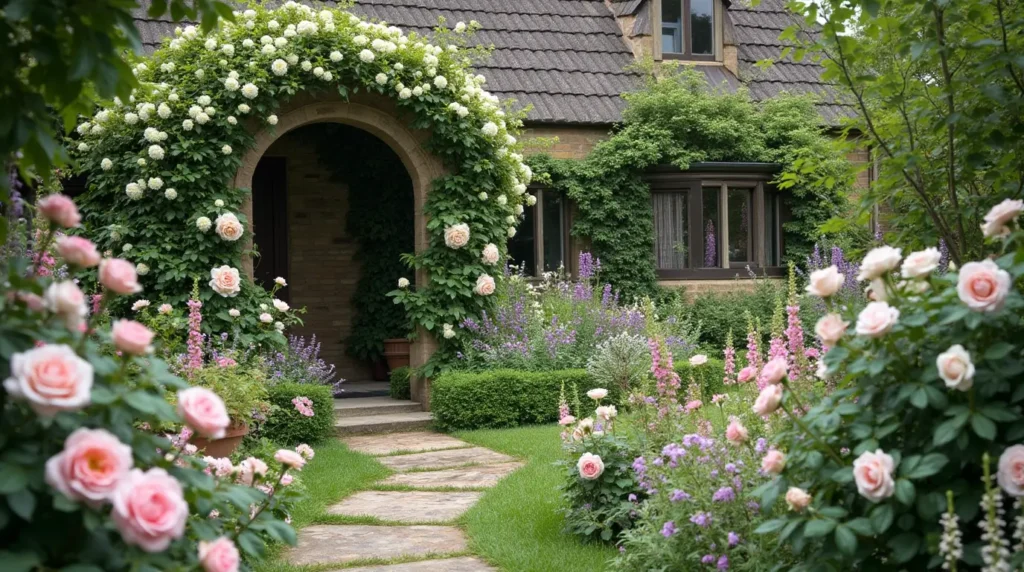
Rose landscaping uses often include climbing roses as a means of transforming bland walls, fences, or garden structures into vibrant, blooming masterpieces. They are perfect for framing entryways, softening hardscapes, and adding layers of color and texture to your outdoor space. Whether you’re designing a romantic garden or simply looking to add depth to your landscape, climbing roses are an elegant and functional choice.
Climbing roses are also versatile in their design applications. Use them to:
- Create living walls by training them along trellises or garden fences.
- Add a touch of romance to pathways and entryways by growing them over arches or arbors.
- Enhance garden height by using them as focal points on pergolas or vertical posts.
Their ability to bloom profusely throughout the season ensures they’ll be a show-stopping addition to your garden.
Best Structures for Climbing Roses
To make the most of climbing roses, providing the right support structure is crucial. Here are some popular options for showcasing their beauty:
- Arbors: Arbors are classic garden elements that look breathtaking when adorned with climbing roses. They are perfect for creating inviting entryways or framing a special area in the garden. Choose arbors made of durable materials like wood or metal to support the weight of the plants as they grow.
- Pergolas: Pergolas provide a larger framework, making them ideal for creating shaded walkways or seating areas. When climbing roses are trained to cover a pergola, they create a natural canopy of blooms and foliage, offering both beauty and functionality.
- Trellises: Trellises are versatile and can be placed against walls, and fences, or used as standalone features. They’re great for small spaces or to add interest to plain vertical surfaces. Trellises come in various sizes and designs, allowing you to match them to your garden style.
- Walls and Fences: Climbing roses can transform dull walls or fences into living works of art. Use horizontal wires or mesh to guide the roses as they climb, ensuring even coverage and a cohesive look.
How to Train Climbing Roses on Vertical Surfaces
To achieve the best results with climbing roses, proper training and care are essential. Here are some tips to guide their growth and keep them healthy:
- Choosing the Right Spot: Climbing roses thrive in areas with full sun, receiving at least 6 hours of sunlight per day. Select a location with well-draining soil and adequate air circulation to prevent fungal diseases.
- Supporting Growth: Use ties or garden twine to gently secure the canes to the chosen structure. Avoid tying them too tightly, as this may harm the plant. Focus on spreading the canes horizontally across the structure to encourage more blooms.
- Pruning for Shape and Health: Prune climbing roses annually, ideally in late winter or early spring. Remove any dead, weak, or overcrowded growth to promote air circulation and healthy blooming. Cut back older canes to encourage the development of new, vigorous shoots.
- Feeding and Watering: Regular watering is vital, especially during dry spells. Ensure the base of the plant is well-mulched to retain moisture and suppress weeds. Use a rose-specific fertilizer to provide the nutrients needed for robust growth and vibrant flowers.
- Pest and Disease Management: Monitor the roses for common issues like aphids, black spots, or powdery mildew. Treat infestations promptly with organic sprays or other recommended methods to keep your climbing roses looking their best.
By incorporating these practices, you can enjoy the full potential of climbing roses in your garden design. Whether covering a trellis with cascading blooms or creating a romantic pergola walkway, climbing roses offer endless possibilities for rose landscaping uses.
Ground Cover Roses: Low Maintenance Landscaping Solution
What Are Ground Cover Roses?
Ground cover roses are a low-growing variety of roses that spread horizontally rather than climbing or growing upright. They are bred for their ability to cover large areas of ground, making them an excellent choice for gardeners looking to fill bare patches in their landscape. These roses are particularly popular in rose landscaping uses due to their versatility, ease of care, and ability to create a vibrant, lush carpet of blooms.

Unlike traditional rose bushes, ground-cover roses require minimal pruning and are highly disease-resistant. They produce abundant flowers throughout the growing season, providing continuous color and visual interest. Available in various colors and sizes, ground cover roses can fit seamlessly into any garden style, from formal landscapes to naturalistic designs.
Common uses for ground cover roses include:
- Covering slopes and embankments to prevent soil erosion.
- Filling spaces between shrubs or trees for added texture.
- Creating borders along pathways or garden beds for a neat, finished look.
Benefits of Using Ground Cover Roses in Landscaping
Ground-cover roses offer numerous advantages, making them a practical and beautiful addition to any garden design. Here are the top benefits of incorporating these roses into your landscape:
- Low Maintenance: Ground cover roses are among the easiest roses to care for. They require minimal pruning and are naturally hardy, thriving in various climates and soil conditions. Their resilience makes them perfect for gardeners seeking beauty without extensive upkeep.
- Weed Control: These roses spread densely, forming a natural barrier that suppresses weed growth. Their thick foliage and sprawling habit reduce the need for frequent weeding, saving time and effort.
- Erosion Prevention: Ground-cover roses are ideal for planting on slopes or embankments. Their sprawling roots stabilize the soil, reducing erosion and improving the overall health of the landscape.
- Continuous Color: Ground cover roses bloom profusely throughout the growing season, adding vibrant color to garden spaces. Their flowers come in various hues, from soft pastels to bold, striking shades, enhancing the garden’s aesthetic appeal.
- Wildlife Attraction: The abundant blooms of ground-cover roses attract pollinators such as bees and butterflies, contributing to the biodiversity of your garden.
Planting Tips for Ground Cover Roses
To achieve the best results with ground cover roses, proper planting, and spacing are essential. Here are some practical tips to ensure these roses thrive in your landscape: Minimal pruning is required. Remove dead or damaged branches in late winter or early spring to encourage new growth. Trim back any overly vigorous stems to maintain a neat appearance.
Selecting the Right Variety: Choose ground-cover roses suited to your climate and soil type. Popular varieties include ‘Flower Carpet,’ ‘Drift Roses,’ and ‘The Fairy.’ These varieties are known for their durability, disease resistance, and prolific blooming.
Choosing the Right Location: Ground-cover roses thrive in areas with full sun, receiving at least 6 hours of sunlight daily. Make sure the site has well-draining soil to avoid waterlogging, as it can cause root rot.
Planting and Spacing: Space the roses about 2–3 feet apart to allow for proper air circulation and full coverage as they spread. Dig a hole slightly larger than the plant’s root ball, place the rose in the hole, and backfill with soil. Water the soil well after planting to help settle it around the roots.
Soil Preparation: Enrich the soil with organic matter, such as compost or well-rotted manure, to provide the nutrients needed for healthy growth. Adding a layer of mulch around the plants helps retain moisture, suppress weeds, and regulate soil temperature.
Watering and Feeding: Ground cover roses need consistent watering during their first growing season to establish strong roots. After that, they are relatively drought-tolerant but will benefit from regular watering during dry spells. Feed them with a balanced rose fertilizer in early spring and mid-summer for optimal blooming.
Pruning and Maintenance: Minimal pruning is required. Remove dead or damaged branches in late winter or early spring to encourage new growth. Trim back any overly vigorous stems to maintain a neat appearance.
Rose Arbors: Adding Elegance and Structure to Your Garden
What Are Rose Arbors and How to Incorporate Them?
A rose arbor is a garden structure typically composed of a framework, such as a wooden or metal arch, over which roses can be trained to grow. It serves as both a functional and aesthetic feature, providing vertical interest and creating a defined entry or pathway in the garden. Arbors not only add elegance but also structure to the landscape, making them ideal for framing doorways, gateways, or creating a central focal point in your garden design.

Incorporating a rose arbor into your garden allows you to introduce rose landscaping uses that elevate the entire outdoor space. Whether it’s placed at the entrance to a garden, along a walkway, or as a focal point in the center of a yard, a well-planted rose arbor can create an enchanting, intimate atmosphere. It serves as a perfect spot to sit and enjoy the beauty of nature, surrounded by fragrant blooms.
Here are a few ways to incorporate rose arbors into your landscape:
- Garden Entrances: Place an arbor at the entrance to your garden or patio area for a welcoming touch.
- Garden Walkways: Use a rose arbor to frame a pathway, leading guests through an enchanting tunnel of blooms.
- Outdoor Dining Areas: Position a rose arbor above a seating area or dining nook to create a shaded, cozy retreat.
By choosing the right location, a rose arbor becomes an integral part of your garden, blending natural beauty with structural design.
Best Rose Varieties for Arbors
When selecting roses for your arbor, it’s important to choose varieties that are well-suited to vertical growth and capable of covering the structure effectively. The best rose varieties for arbors are typically climbing roses and rambling roses. These types of roses have the ability to grow long, flexible canes that can easily be trained to cover the entire framework of the arbor.
- Climbing Roses: Climbing roses, such as ‘New Dawn’, ‘Cecile Brunner’, and ‘Don Juan’, are excellent for arbors. They have long, vigorous canes that, when properly supported, can grow upwards and horizontally, creating a cascading effect of beautiful blooms.
- ‘New Dawn’ is a classic climbing rose, known for its soft pink flowers and repeated blooming cycle.
- ‘Don Juan’ offers rich red blooms with a strong fragrance, making it a standout choice for arbors.
- ‘Cecile Brunner’ features delicate, small pink blooms and a refined look, perfect for an elegant garden setting.
- Rambling Roses: Rambling roses are similar to climbing roses but tend to have even longer, more flexible canes. They typically flower once in early summer but produce a stunning display of flowers.
- ‘Kiftsgate’ is a large, white-flowering rambling rose that is perfect for creating a dramatic statement on arbors.
- ‘Alberic Barbier’ is another rambling rose with creamy yellow flowers, offering a timeless, romantic appearance.
Both climbing and rambling roses will bring elegance and fragrance to your arbor, adding a natural curtain of flowers that provides beauty and privacy in the garden.
Caring for Rose Arbors
To ensure your roses thrive on the arbor and continue to add beauty to your garden, proper care and maintenance are key. Here are essential tips for rose landscaping uses when it comes to caring for rose arbors:
- Pruning and Training: Regular pruning is essential for maintaining the shape and health of the climbing or rambling roses on your arbor. In early spring, after the danger of frost has passed, prune back any dead or diseased canes. Cut back any overly long or unruly growth to encourage a neat appearance and better airflow. Train the new growth by gently tying the canes to the arbor with garden twine or ties. Spread the canes horizontally along the structure to promote more blooms and prevent overcrowding. Be sure not to tie the canes too tightly, as this can damage the plants. Rambling roses typically require less frequent pruning than climbing roses but should still be managed to prevent excessive growth and ensure a healthy, balanced shape.
- Feeding and Watering: Roses thrive on regular feeding to promote abundant blooms. Use a balanced rose fertilizer in the spring and again in mid-summer to ensure continuous flowering. Always follow the manufacturer’s instructions to avoid over-fertilizing. Provide the roses with deep and consistent watering, particularly during periods of dry weather. Ensure the soil is moist but well-draining, as roses are susceptible to root rot in waterlogged conditions.
- Disease and Pest Management: Keep an eye out for common rose pests such as aphids, spider mites, and black spot fungus. Regularly inspect the foliage and canes for signs of pest activity or disease. If necessary, treat with an organic pest spray or fungicide to maintain healthy growth. Ensure proper air circulation around the arbor to minimize the risk of fungal diseases. Refrain from watering from above, as it may encourage fungal growth on the leaves.
- Winter Care: In colder climates, protect your rose arbor by wrapping the base of the plants with burlap or other frost protection materials. Ensure the roses are well-pruned and provide extra mulch around the roots for insulation.
By following these care tips, your rose arbor will thrive for many years, becoming an essential and stunning feature in your garden.
Introduction
Roses have long been celebrated as one of the most iconic flowers in gardening, revered for their timeless beauty, captivating fragrance, and unparalleled versatility. Whether you’re a seasoned gardener or a beginner looking to enhance your outdoor space, roses can play a pivotal role in elevating the aesthetic appeal of your garden.

In this blog post, we’ll explore how roses can transform your landscaping efforts, turning ordinary spaces into extraordinary havens of color and charm. From creating elegant borders that frame your garden to designing stunning arbors dripping with climbing roses, the possibilities are as vast as they are enchanting.
What makes roses particularly special in landscaping is their ability to adapt to a wide range of styles and settings. They can be the focal point of a formal garden, a romantic addition to a cottage-style landscape, or a low-maintenance solution for those who want beauty without the hassle.
This guide will walk you through creative ways to incorporate roses into your garden design. Whether you’re interested in crafting seamless garden edges, building dramatic rose arbors, or blending roses with other plants in a cottage-style setting, we’ve got you covered.
Let’s dive in and uncover the charm of rose landscaping—your outdoor oasis is just a bloom away!

